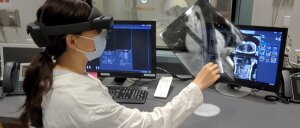by
John R. Fischer, Senior Reporter | November 02, 2022

Researchers are developing a hybrid MR scanner where physicians can perform robotic heart catheterizations on patients while they undergo imaging. (Photo courtesy of Case Western Reserve University)
Researchers at Case Western Reserve University have secured a four-year, $3.7 million grant that will go toward the development of technology for a potential future procedure in which robotic heart catheterizations are completed on patients while inside MR scanners.
The operation would be a medical first, according to the researchers, who say that a physician would control a micro-robotic device to perform an operation and use an augmented reality headset to view soft tissues and organs in real time. They are developing the technology with the intent to perform left atrial appendage occlusion to manage stroke risk in atrial fibrillation patients.
“He or she would be able to pinpoint the exact location, and the micro-robot would perform the procedure. This would make this procedure safer, easier, far more effective, and even less expensive as a treatment for atrial fibrillation (AFib),” said lead researcher M. Cenk Cavusoglu, professor of electrical, computer, and systems engineering, and director of the Medical Robotics and Computer Integrated Surgery Lab at the Case School of Engineering, in a statement.



Ad Statistics
Times Displayed: 46925
Times Visited: 1427 MIT labs, experts in Multi-Vendor component level repair of: MRI Coils, RF amplifiers, Gradient Amplifiers Contrast Media Injectors. System repairs, sub-assembly repairs, component level repairs, refurbish/calibrate. info@mitlabsusa.com/+1 (305) 470-8013
Current technology requires doctors to view heart tissue via hazy X-ray images and manually position the implant.
In the LAAO procedure laid out by the researchers, the doctor would insert a catheter or flexible tube through a vein or artery in the groin and thread it up to the heart to position the implant. The device would reduce blood clots in the heart that cause strokes in Afib patients.
Creating the system for this required Cavusoglu to combine a robotic catheter with a high-speed MR system. To do this, he sought input from several experts in different subjects, including radiology and bioengineering, and from the University of Michigan, the University of South Florida, University Hospitals Cleveland Medical Center, and MetroHealth, as well as his own.
The NIH previously granted Cavusoglu and his team a grant in 2020 to develop a similar system for performing MR-guided robotic atrial fibrillation ablation, which could be used on patients who cannot tolerate or respond to drugs.
They have been working on this approach since 2013 and seek to validate it in preclinical trials within the next few years.

